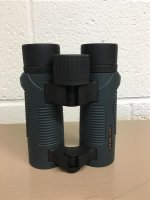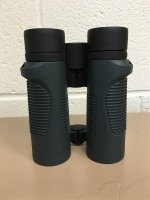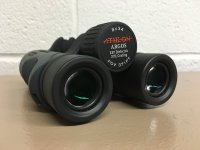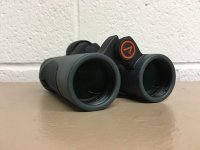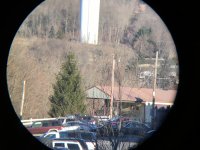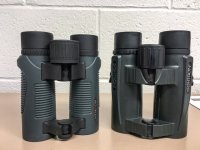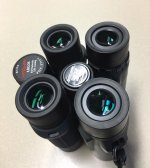FrankD
Well-known member
I haven’t had much time lately to sit down and share my thoughts on a few of the more recent binoculars that have graced my home. Besides all of the usual holiday hustle and bustle I have been intently birding my local patch(es) in search of any new and interesting birds. With the holidays over and a great start to my year list I thought it was time to finally sit down and put something together for the handful of models worthy of review. First on the list is the Athlon Argos.
I am sure your first thought after reading that statement is “who is Athlon” and what is the Argos model. Athlon is relatively new company staffed by a variety of gifted individuals that had worked for Bushnell in recent years. These gentlemen had the idea that they could offer high quality optics directly to consumers at a very reasonable price. It seems they succeeded from what I have seen with the Argos model.
Athlon Optics has 6 binocular lines and 2 spotting scope lines. Each line is geared for a specific level of performance for that particular price point. Their most expensive binocular model, the Cronus, has an MSRP just under $600 but sports an impressive list of features not the least of which being a field flattener element.
So where does the Argos fit into their lineup?
Its price point, around $200 MSRP, puts in the lower middle of their various binocular lines. The inevitable question is why I would request to have one of the lower price models for review instead of one of their higher price and higher performing models. Well, there are a few answers to that question. For one, I look for the best “value” in terms of optics. I would much rather spend $200 on a binocular that performs like the average $400 model rather than spend $400 on an average $400 model.
Second, some of the specs and features of the Argos jumped out at me. For one it is lightweight. Two it is an open bridge design. Three it has an advertised 34 mm objective diameter and, four, it had a listed field of view of over 400 feet. The last point, as it turns out, was a typo on the website. The actual field of view is 7.1 degrees (371 feet)…..a bit of a letdown but not a deal breaker when you handle and look through this model.
Lastly, I did also request their high end Cronus model but it was not available prior to the holidays (hopefully more on that in the near future).
So let us start with the basic advertised specifications and features:
POWER 8X
OBJECTIVE LENS DIAMETER 34 mm
EYE RELIEF 17.4 mm
FIELD OF VIEW ANGULAR 7.1°
FIELD OF VIEW FEET @1000 Yards 407 ft
FIELD OF VIEW METERS @1000 METERS 137 m
CLOSE FOCUS 4 m /13 ft
INTERPUPILLARY DISTANCE 56 mm-76 mm
WEIGHT 16.3 oz
ESP Dielectric Coating- Enhanced Spectral Prism Dielectric Coating ESP Dielectric Coating is a multi layer prism coating that reflects over 99% of the light to your eyes bringing you a clear, bright image that displays accurate color reproduction.
XPL Coating- Xtra Protective Layer coating XPL Coating gives you an extra protection on the exterior lenses from dirt, oil and scratches
Phase Corrected prisms Phase corrected prisms produce images that have better contrast, a higher resolution and better color reproduction
BaK4 prisms Bak-4 glass prisms reflect more light to your eyes which will give you brighter and sharper image.
Advanced FMC Advanced Fully Multi-Coated lenses gives you better light transmission to bring optimum brightness and true color across the entire light spectrum.
Long Eye Relief Long eye relief can be particularly important for eyeglass wearers because longer eye relief allows them to still see the entire field of view.
Close Focus Close focus is important for those who are nature observers and especially important if you are going to watch butterflies or insects
Twist Up Eyecups Twist up eyecups with intermediate stops allow you to set the eyecups to the ideal eye relief for you eyes
Waterproof Waterproof to protect the binocular in the harshest weather conditions or if accidentally submerged underwater
That information is a direct copy/paste from the Athlon website. So, as you can see, the only two features that it does not offer are ED glass and a field flattening element in the eyepiece design. Keep in mind this model does have a regular “street price” of around $170.
Optical Performance:
Optical performance is always my first place to start. Don’t get me wrong. I think ergonomics and mechanics can play an equally important role but optical performance is the foundation to which the other two build upon (in my opinion).
As mentioned above the field of view should be considered average for a 30-something class binocular. Typically as you move up in objective size with a particular binocular line you lose field of view (assuming all else is equal). Your normal 8x30 or 8x32 model has an average field of view around 393 feet (7.5 degrees) with some of the more impressive models approaching and exceeding 420 feet. The 34 mm objective brings that field of view down a bit but not objectionably so.
So what strikes me about the optical performance of this model?
Good question. I think, optically, the size of the sweet spot and the overall transition from the sweet spot out to the field stop is what I like most. The apparent sweet spot size is approximately 80% of the field with a very gradual transition to the out of focus edge of the field of view. Image deterioration at the edge seems to be entirely field curvature. The out of focus area is only just out of focus as a slight bump of the focusing knob brings it into focus.
How about the other optical performance areas such as apparent brightness, sharpness, contrast, etc…?
My experience with this and other models at this price point leads me to believe that it is slightly above average in most areas. Apparent sharpness within the sweet spot is more than acceptable. The contrast level is good but not very good or excellent. CA control is surprisingly better than expected within the sweet spot. Apparent brightness is above average. The image also has a neutral to ever so slightly warm color representation.
So what do I think about the overall image representation?
I like it. The combination of sweet spot size, color representation and apparent sharpness all make the image seem very natural to my eyes. There isn’t any eyestrain either because of alignment issues or excessive distortions or aberrations. So, in other words, the binocular is a solid little performer at the $200 price point. I definitely prefer its optical performance over some other recently introduced models reviewed previously at this price point.
The minimum close focusing distance for my eyes is approximately 7 feet.
Ergonomics:
No optical performance pun intended but I think this is where this model really shines. I genuinely love the ergonomics of this model. The barrels are long and without bumps or extrusions. As a result there is plenty of room for your fingers to fit in between the barrels. In addition the eyecups are nicely contoured along the rim so the eyecups fit comfortably in/around my eye sockets.
The binoculars feel even more lightweight than their listed 16.3 ounce weight which is most likely the result of open bridge design coupled with the fairly long , for a 30 mm class, barrels (5.25 inches). The focusing knob is large and the positioning of the open bridge design easily allows my index finger to rest comfortably across it during regular use.
The ocular diameter appears fairly large in relation to the diameter of the eyecups. In my experience this makes for easy eye placement especially when coupled with the 4.25 mm exit pupil (and as opposed to the 3.75 mm exit pupil of an 8x30 model).
Mechanics:
In regular use I have no major objections to the mechanical performance of this model. I do have some nitpicks though that I will get into shortly. Central hinge tension is good with the IPD setting not moving during regular use. Focusing direction is counterclockwise from close focus to infinity. It takes approximately 1.5 turns of the focusing knob to cover that distance with a little (1/4 of a turn) remaining beyond infinity for my eyes. Focusing tension is smooth with slightly less than average tension. I do not find this objectionable since the focusing speed is average to slightly slow.
There is a small amount of play in the focusing knob at one point in the focusing range. It is not large, maybe 1/8th of an inch but I do notice it on occasion during regular use.
The eyecups rotate out for non-eyeglass wearing individuals. I don’t wear glasses but typically have to use a binocular with the eyecups fully collapsed to see the full field of view. Blame my big nose and close-set eyes for that situation. The eyecups work very well either fully collapsed or fully extended. There feels like there should be an intermediate setting but the eyecups do not stay set in any position other than the two mentioned.
Summary:
So what are my final thoughts on this model?
In general I like it. It fits a useful niche. The binocular is smaller than a full-sized 40 mm model and light enough for you to wear around your neck all day and not even notice that it is there. The ergonomics are excellent in my opinion. I love holding and using this model. Optically it punches slightly above its price point. If only the field of view was closer to its advertised 407 feet I think I might be more enthusiastic about its overall optical performance. Still, even with that small nitpick I could easily see myself using this little model as a regular day to day binocular….and let us not forget one of its more appealing overall characteristics….its price.
I am sure your first thought after reading that statement is “who is Athlon” and what is the Argos model. Athlon is relatively new company staffed by a variety of gifted individuals that had worked for Bushnell in recent years. These gentlemen had the idea that they could offer high quality optics directly to consumers at a very reasonable price. It seems they succeeded from what I have seen with the Argos model.
Athlon Optics has 6 binocular lines and 2 spotting scope lines. Each line is geared for a specific level of performance for that particular price point. Their most expensive binocular model, the Cronus, has an MSRP just under $600 but sports an impressive list of features not the least of which being a field flattener element.
So where does the Argos fit into their lineup?
Its price point, around $200 MSRP, puts in the lower middle of their various binocular lines. The inevitable question is why I would request to have one of the lower price models for review instead of one of their higher price and higher performing models. Well, there are a few answers to that question. For one, I look for the best “value” in terms of optics. I would much rather spend $200 on a binocular that performs like the average $400 model rather than spend $400 on an average $400 model.
Second, some of the specs and features of the Argos jumped out at me. For one it is lightweight. Two it is an open bridge design. Three it has an advertised 34 mm objective diameter and, four, it had a listed field of view of over 400 feet. The last point, as it turns out, was a typo on the website. The actual field of view is 7.1 degrees (371 feet)…..a bit of a letdown but not a deal breaker when you handle and look through this model.
Lastly, I did also request their high end Cronus model but it was not available prior to the holidays (hopefully more on that in the near future).
So let us start with the basic advertised specifications and features:
POWER 8X
OBJECTIVE LENS DIAMETER 34 mm
EYE RELIEF 17.4 mm
FIELD OF VIEW ANGULAR 7.1°
FIELD OF VIEW FEET @1000 Yards 407 ft
FIELD OF VIEW METERS @1000 METERS 137 m
CLOSE FOCUS 4 m /13 ft
INTERPUPILLARY DISTANCE 56 mm-76 mm
WEIGHT 16.3 oz
ESP Dielectric Coating- Enhanced Spectral Prism Dielectric Coating ESP Dielectric Coating is a multi layer prism coating that reflects over 99% of the light to your eyes bringing you a clear, bright image that displays accurate color reproduction.
XPL Coating- Xtra Protective Layer coating XPL Coating gives you an extra protection on the exterior lenses from dirt, oil and scratches
Phase Corrected prisms Phase corrected prisms produce images that have better contrast, a higher resolution and better color reproduction
BaK4 prisms Bak-4 glass prisms reflect more light to your eyes which will give you brighter and sharper image.
Advanced FMC Advanced Fully Multi-Coated lenses gives you better light transmission to bring optimum brightness and true color across the entire light spectrum.
Long Eye Relief Long eye relief can be particularly important for eyeglass wearers because longer eye relief allows them to still see the entire field of view.
Close Focus Close focus is important for those who are nature observers and especially important if you are going to watch butterflies or insects
Twist Up Eyecups Twist up eyecups with intermediate stops allow you to set the eyecups to the ideal eye relief for you eyes
Waterproof Waterproof to protect the binocular in the harshest weather conditions or if accidentally submerged underwater
That information is a direct copy/paste from the Athlon website. So, as you can see, the only two features that it does not offer are ED glass and a field flattening element in the eyepiece design. Keep in mind this model does have a regular “street price” of around $170.
Optical Performance:
Optical performance is always my first place to start. Don’t get me wrong. I think ergonomics and mechanics can play an equally important role but optical performance is the foundation to which the other two build upon (in my opinion).
As mentioned above the field of view should be considered average for a 30-something class binocular. Typically as you move up in objective size with a particular binocular line you lose field of view (assuming all else is equal). Your normal 8x30 or 8x32 model has an average field of view around 393 feet (7.5 degrees) with some of the more impressive models approaching and exceeding 420 feet. The 34 mm objective brings that field of view down a bit but not objectionably so.
So what strikes me about the optical performance of this model?
Good question. I think, optically, the size of the sweet spot and the overall transition from the sweet spot out to the field stop is what I like most. The apparent sweet spot size is approximately 80% of the field with a very gradual transition to the out of focus edge of the field of view. Image deterioration at the edge seems to be entirely field curvature. The out of focus area is only just out of focus as a slight bump of the focusing knob brings it into focus.
How about the other optical performance areas such as apparent brightness, sharpness, contrast, etc…?
My experience with this and other models at this price point leads me to believe that it is slightly above average in most areas. Apparent sharpness within the sweet spot is more than acceptable. The contrast level is good but not very good or excellent. CA control is surprisingly better than expected within the sweet spot. Apparent brightness is above average. The image also has a neutral to ever so slightly warm color representation.
So what do I think about the overall image representation?
I like it. The combination of sweet spot size, color representation and apparent sharpness all make the image seem very natural to my eyes. There isn’t any eyestrain either because of alignment issues or excessive distortions or aberrations. So, in other words, the binocular is a solid little performer at the $200 price point. I definitely prefer its optical performance over some other recently introduced models reviewed previously at this price point.
The minimum close focusing distance for my eyes is approximately 7 feet.
Ergonomics:
No optical performance pun intended but I think this is where this model really shines. I genuinely love the ergonomics of this model. The barrels are long and without bumps or extrusions. As a result there is plenty of room for your fingers to fit in between the barrels. In addition the eyecups are nicely contoured along the rim so the eyecups fit comfortably in/around my eye sockets.
The binoculars feel even more lightweight than their listed 16.3 ounce weight which is most likely the result of open bridge design coupled with the fairly long , for a 30 mm class, barrels (5.25 inches). The focusing knob is large and the positioning of the open bridge design easily allows my index finger to rest comfortably across it during regular use.
The ocular diameter appears fairly large in relation to the diameter of the eyecups. In my experience this makes for easy eye placement especially when coupled with the 4.25 mm exit pupil (and as opposed to the 3.75 mm exit pupil of an 8x30 model).
Mechanics:
In regular use I have no major objections to the mechanical performance of this model. I do have some nitpicks though that I will get into shortly. Central hinge tension is good with the IPD setting not moving during regular use. Focusing direction is counterclockwise from close focus to infinity. It takes approximately 1.5 turns of the focusing knob to cover that distance with a little (1/4 of a turn) remaining beyond infinity for my eyes. Focusing tension is smooth with slightly less than average tension. I do not find this objectionable since the focusing speed is average to slightly slow.
There is a small amount of play in the focusing knob at one point in the focusing range. It is not large, maybe 1/8th of an inch but I do notice it on occasion during regular use.
The eyecups rotate out for non-eyeglass wearing individuals. I don’t wear glasses but typically have to use a binocular with the eyecups fully collapsed to see the full field of view. Blame my big nose and close-set eyes for that situation. The eyecups work very well either fully collapsed or fully extended. There feels like there should be an intermediate setting but the eyecups do not stay set in any position other than the two mentioned.
Summary:
So what are my final thoughts on this model?
In general I like it. It fits a useful niche. The binocular is smaller than a full-sized 40 mm model and light enough for you to wear around your neck all day and not even notice that it is there. The ergonomics are excellent in my opinion. I love holding and using this model. Optically it punches slightly above its price point. If only the field of view was closer to its advertised 407 feet I think I might be more enthusiastic about its overall optical performance. Still, even with that small nitpick I could easily see myself using this little model as a regular day to day binocular….and let us not forget one of its more appealing overall characteristics….its price.




